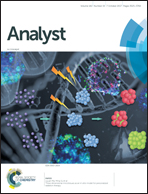A microfluidic device for the batch adsorption of a protein on adsorbent particles†
Abstract
A microfluidic platform or “microfluidic batch adsorption device” is presented, which performs two sets of 9 parallel protein incubations with/without adsorbent particles to achieve an adsorption isotherm of a protein in a single experiment. The stepwise concentration gradient of a target protein was created by the integration of microvalves into the device. The nanoliter-scale reactor (41 nl) allows about 5000 times reduction of sample consumption and fast analysis compared with a conventional 96 well plate. The integration of two sets of parallel reactors as reference reactors and adsorption reactors, respectively, in a single microfluidic format has many advantages, such as the exclusion of the influence of undesired experimental fluctuations, and the possibility of real-time tracing of adsorption processes. We performed batch adsorption of albumin–fluorescein isothiocyanate conjugate (FITC-BSA) on polymeric particles (Source 15Q) to obtain an adsorption isotherm. The obtained on-chip parameters maximum adsorption amount (Qmax) and adsorption constant (Keq) were 0.33 ± 0.03 ng per particle and 0.97 ± 0.22 L g−1, respectively, which are in good agreement with off-chip values (Qmax = 0.34 ± 0.01 ng per particle and Keq = 0.81 ± 0.10 L g−1). On-chip adsorption isotherms of FITC-BSA at various concentrations of sodium chloride (NaCl) were measured to evaluate the effect of this salt on the adsorption capability of Source 15Q. The microfluidic device serves as a new analytical tool, useful in biotechnological and industrial applications, where the adsorption behavior of (bio)molecules on commercial adsorbent particles plays critical roles, such as protein separation and purification, detection of analytes and biomarkers, and solid-phase immunoassays.



 Please wait while we load your content...
Please wait while we load your content...